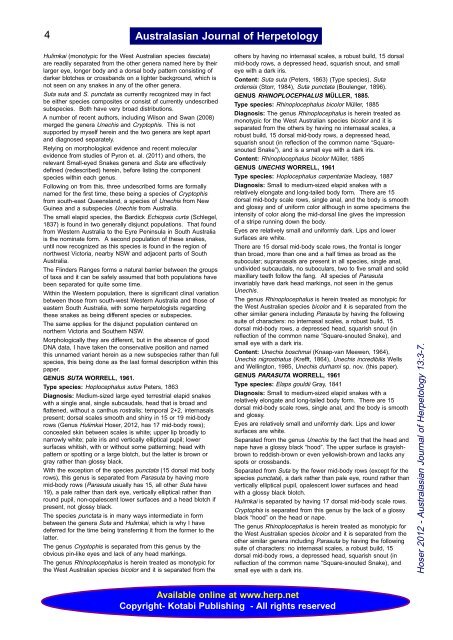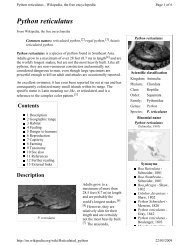Issue Thirteen 30 June 2012 - Taxonomic issue - all - Smuggled.com
Issue Thirteen 30 June 2012 - Taxonomic issue - all - Smuggled.com
Issue Thirteen 30 June 2012 - Taxonomic issue - all - Smuggled.com
Create successful ePaper yourself
Turn your PDF publications into a flip-book with our unique Google optimized e-Paper software.
4<br />
Hulimkai (monotypic for the West Australian species fasciata)<br />
are readily separated from the other genera named here by their<br />
larger eye, longer body and a dorsal body pattern consisting of<br />
darker blotches or crossbands on a lighter background, which is<br />
not seen on any snakes in any of the other genera.<br />
Suta suta and S. punctata as currently recognized may in fact<br />
be either species <strong>com</strong>posites or consist of currently undescribed<br />
subspecies. Both have very broad distributions.<br />
A number of recent authors, including Wilson and Swan (2008)<br />
merged the genera Unechis and Cryptophis. This is not<br />
supported by myself herein and the two genera are kept apart<br />
and diagnosed separately.<br />
Relying on morphological evidence and recent molecular<br />
evidence from studies of Pyron et. al. (2011) and others, the<br />
relevant Sm<strong>all</strong>-eyed Snakes genera and Suta are effectively<br />
defined (redescribed) herein, before listing the <strong>com</strong>ponent<br />
species within each genus.<br />
Following on from this, three undescribed forms are form<strong>all</strong>y<br />
named for the first time, these being a species of Cryptophis<br />
from south-east Queensland, a species of Unechis from New<br />
Guinea and a subspecies Unechis from Australia.<br />
The sm<strong>all</strong> elapid species, the Bardick Echiopsis curta (Schlegel,<br />
1837) is found in two gener<strong>all</strong>y disjunct populations. That found<br />
from Western Australia to the Eyre Peninsula in South Australia<br />
is the nominate form. A second population of these snakes,<br />
until now recognized as this species is found in the region of<br />
northwest Victoria, nearby NSW and adjacent parts of South<br />
Australia.<br />
The Flinders Ranges forms a natural barrier between the groups<br />
of taxa and it can be safely assumed that both populations have<br />
been separated for quite some time.<br />
Within the Western population, there is significant clinal variation<br />
between those from south-west Western Australia and those of<br />
eastern South Australia, with some herpetologists regarding<br />
these snakes as being different species or subspecies.<br />
The same applies for the disjunct population centered on<br />
northern Victoria and Southern NSW.<br />
Morphologic<strong>all</strong>y they are different, but in the absence of good<br />
DNA data, I have taken the conservative position and named<br />
this unnamed variant herein as a new subspecies rather than full<br />
species, this being done as the last formal description within this<br />
paper.<br />
GENUS SUTA WORRELL, 1961.<br />
Type species: Hoplocephalus sutus Peters, 1863<br />
Diagnosis: Medium-sized large eyed terrestrial elapid snakes<br />
with a single anal, single subcaudals, head that is broad and<br />
flattened, without a canthus rostralis; temporal 2+2, internasals<br />
present; dorsal scales smooth and shiny in 15 or 19 mid-body<br />
rows (Genus Hulimkai Hoser, <strong>2012</strong>, has 17 mid-body rows);<br />
concealed skin between scales is white; upper lip broadly to<br />
narrowly white; pale iris and vertic<strong>all</strong>y elliptical pupil; lower<br />
surfaces whitish, with or without some patterning; head with<br />
pattern or spotting or a large blotch, but the latter is brown or<br />
gray rather than glossy black.<br />
With the exception of the species punctata (15 dorsal mid body<br />
rows), this genus is separated from Parasuta by having more<br />
mid-body rows (Parasuta usu<strong>all</strong>y has 15, <strong>all</strong> other Suta have<br />
19), a pale rather than dark eye, vertic<strong>all</strong>y elliptical rather than<br />
round pupil, non-opalescent lower surfaces and a head blotch if<br />
present, not glossy black.<br />
The species punctata is in many ways intermediate in form<br />
between the genera Suta and Hulimkai, which is why I have<br />
deferred for the time being transferring it from the former to the<br />
latter.<br />
The genus Cryptophis is separated from this genus by the<br />
obvious pin-like eyes and lack of any head markings.<br />
The genus Rhinoplocephalus is herein treated as monotypic for<br />
the West Australian species bicolor and it is separated from the<br />
Australasian Journal of Herpetology<br />
others by having no internasal scales, a robust build, 15 dorsal<br />
mid-body rows, a depressed head, squarish snout, and sm<strong>all</strong><br />
eye with a dark iris.<br />
Content: Suta suta (Peters, 1863) (Type species), Suta<br />
ordensis (Storr, 1984), Suta punctata (Boulenger, 1896).<br />
GENUS RHINOPLOCEPHALUS MÜLLER, 1885.<br />
Type species: Rhinoplocephalus bicolor Müller, 1885<br />
Diagnosis: The genus Rhinoplocephalus is herein treated as<br />
monotypic for the West Australian species bicolor and it is<br />
separated from the others by having no internasal scales, a<br />
robust build, 15 dorsal mid-body rows, a depressed head,<br />
squarish snout (in reflection of the <strong>com</strong>mon name “Squaresnouted<br />
Snake”), and is a sm<strong>all</strong> eye with a dark iris.<br />
Content: Rhinoplocephalus bicolor Müller, 1885<br />
GENUS UNECHIS WORRELL, 1961<br />
Type species: Hoplocephalus carpentariae Macleay, 1887<br />
Diagnosis: Sm<strong>all</strong> to medium-sized elapid snakes with a<br />
relatively elongate and long-tailed body form. There are 15<br />
dorsal mid-body scale rows, single anal, and the body is smooth<br />
and glossy and of uniform color although in some specimens the<br />
intensity of color along the mid-dorsal line gives the impression<br />
of a stripe running down the body.<br />
Eyes are relatively sm<strong>all</strong> and uniformly dark. Lips and lower<br />
surfaces are white.<br />
There are 15 dorsal mid-body scale rows, the frontal is longer<br />
than broad, more than one and a half times as broad as the<br />
subocular; supranasals are present in <strong>all</strong> species, single anal,<br />
undivided subcaudals, no suboculars, two to five sm<strong>all</strong> and solid<br />
maxillary teeth follow the fang. All species of Parasuta<br />
invariably have dark head markings, not seen in the genus<br />
Unechis.<br />
The genus Rhinoplocephalus is herein treated as monotypic for<br />
the West Australian species bicolor and it is separated from the<br />
other similar genera including Parasuta by having the following<br />
suite of characters: no internasal scales, a robust build, 15<br />
dorsal mid-body rows, a depressed head, squarish snout (in<br />
reflection of the <strong>com</strong>mon name “Square-snouted Snake), and<br />
sm<strong>all</strong> eye with a dark iris.<br />
Content: Unechis boschmai (Knaap-van Meewen, 1964),<br />
Unechis nigrostriatus (Krefft, 1864), Unechis incredibilis Wells<br />
and Wellington, 1985, Unechis durhami sp. nov. (this paper).<br />
GENUS PARASUTA WORRELL, 1961<br />
Type species: Elaps gouldii Gray, 1841<br />
Diagnosis: Sm<strong>all</strong> to medium-sized elapid snakes with a<br />
relatively elongate and long-tailed body form. There are 15<br />
dorsal mid-body scale rows, single anal, and the body is smooth<br />
and glossy.<br />
Eyes are relatively sm<strong>all</strong> and uniformly dark. Lips and lower<br />
surfaces are white.<br />
Separated from the genus Unechis by the fact that the head and<br />
nape have a glossy black “hood”. The upper surface is grayishbrown<br />
to reddish-brown or even yellowish-brown and lacks any<br />
spots or crossbands.<br />
Separated from Suta by the fewer mid-body rows (except for the<br />
species punctata), a dark rather than pale eye, round rather than<br />
vertic<strong>all</strong>y elliptical pupil, opalescent lower surfaces and head<br />
with a glossy black blotch.<br />
Hulimkai is separated by having 17 dorsal mid-body scale rows.<br />
Cryptophis is separated from this genus by the lack of a glossy<br />
black “hood” on the head or nape.<br />
The genus Rhinoplocephalus is herein treated as monotypic for<br />
the West Australian species bicolor and it is separated from the<br />
other similar genera including Parasuta by having the following<br />
suite of characters: no internasal scales, a robust build, 15<br />
dorsal mid-body rows, a depressed head, squarish snout (in<br />
reflection of the <strong>com</strong>mon name “Square-snouted Snake), and<br />
sm<strong>all</strong> eye with a dark iris.<br />
Available online at www.herp.net<br />
Copyright- Kotabi Publishing - All rights reserved<br />
Hoser <strong>2012</strong> - Australasian Journal of Herpetology 13:3-7.



